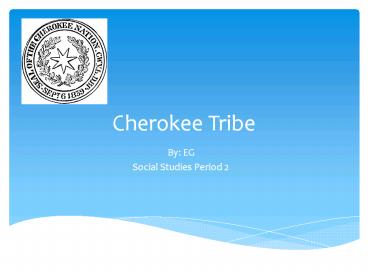Cherokee Tribe - PowerPoint PPT Presentation
1 / 16
Title:
Cherokee Tribe
Description:
Cherokee Tribe By: EG Social Studies Period 2 – PowerPoint PPT presentation
Number of Views:160
Avg rating:3.0/5.0
Title: Cherokee Tribe
1
Cherokee Tribe
- By EG
- Social Studies Period 2
2
Location
- Lived in Appalachain Mountains.
- Towns scattered in modern day North and South
Carolina, Kentucky, Virginia, West Virginia,
Tennessee, Georgia, Alabama, Okalahoma - Lived in the South-Eastern region
3
Population
- Early history- lived in 80 towns or villages
- Each town had about 200-250 people
- Seven Cherokee Clans
- Lived in three major areas Upper, Middle, and
Lower towns
4
Economy
- Agricultural based- respected nature, farmed in
southern Appalachian region. Hunted mostly deer
or bears. Women farmed, men hunted. - Little outside contact, traded with Europeans.
- Traded manufactured goods metal, glass, cloth,
etc. Provided Europeans with deerskin
5
Housing
- Towns were made up of council house, town square,
about 40 homes per town surrounded by fences.
Wall structure by weaving tree branches, roofs
were made by bark, plastered grass or clay over
framework - Council houses made up mud and trees. Different
style houses for summer, winter. Houses quite
large, lived with extended family.
6
Life Now
- Amount of land owned changed the Cherokee.
- Business increase allows tribe members to have
higher salaries and more benefits. - Have more education to prevent past struggles
- Before, loose government it didnt matter what
race you were. Now, Cherokees are a very racial
group. - Jobs Business owners, medical professionals,
craftsmen, Cherokee historians.
7
Anglo-Cherokee War 1758
- Cause Cherokee renewed peace treaty, served to
remove tribe from white settlements. Returned
from French battle in 1757 Cherokee stole whites
supplies. White settlers killed warriors, older
Cherokees tried sending peace treaty as war broke
out.
8
Anglo-Cherokee War 1758
- Effect The Cherokee lost large amounts of land.
Marked turning point in lives. Cherokees had a
stronger commitment to the experiences amongst
the boundaries.
9
Treaty of Augusta 1773
- Cause Spanish, French, and English tried to
colonize Cherokee territory. Cherokee tribes
allied with Britain in trading and military.
During French-Indian war they allied with the
British. British destructed Native towns from
policy. - Effect Economies were disrupted. The Cherokee
exchanged land to pay off debt. Two million
acres in Georgia were abandon.
10
Treaty of Hopewell 1785
- Cause Many battles and conflicts between the
Cherokees. The tribe wanted to create peace
between rivals. They wanted full protection of
their land. The Cherokees thought this would
stop all fighting. - Effect The Cherokees gain boundaries for white
settlements. Land cessions discouraged tribes
from joining other conflicts between Indians and
Whites. The Cherokees were able to maintain
peace and protection from the U.S. but they
followed conditions.
11
Indian Removal Act 1830
- Cause Cherokee had own town in Georgia. They
wanted to establish their own government and
homeland in Georgia. Georgias legislature
passed laws disagreeing with Cherokee. - Effect Georgia took over the Cherokee land.
Cherokee tribe took the case to Supreme Court.
Government passed the Indian Removal Act. Tribes
left their homes.
12
Trail of Tears 1838
- Cause The Indian Removal Act caused Cherokee to
leave their homes. The Government set program
for removal of Native groups to migrate West.
Positive- opened many acres of land towards
Cherokees and other tribes. Negative- Removed by
army, they had possessions to leave their homes
and most.
13
Trail of Tears 1838
- Effect Cherokee and other tribes traveled about
800 miles by foot. While on the trail white
settlers attacked them stealing most of their
things. Over 2,500 people had died.
14
1842 Slave Revolt
- Cause The Cherokee tribe had the largest amount
of slaves. They made them work on farms or as
servants. Cherokees depended on slaves as bridge
to white society. The slaves started a revolt
locking their owners in their homes. - Effect Tribe sent militia to bring back slaves,
they were headed towards Mexico. Rebellious
slaves put to work on steamboats. Cherokees
passed laws saying all free African Americans,
except former Cherokee slaves, are to leave the
nation.
15
Work Cited
- Burton, Art. Slave Revolt of 1842.
Encyclopedia of Oklahoma History Culture. Web. - http//digital.library.okstate.edu/encyclopedia/en
tries/S/SL002.html - "Cherokee." Encyclopedia of Native American
Tribes. Ed. Laurie J. Edwards. Gale Student
Resources In Context. Web. 10 Oct. 2012. - Cherokee Houses. Cherokee. Web.
- http//www.aaanativearts.com/cherokee/cherokee-hou
ses.htm - Conley, Robert. Cherokees. Countries and
Their Cultures. Web - http//www.everyculture.com/multi/Bu-Dr/Cherokees.
html - Indian Removal Act of 1860. Web.
- http//www.webpages.uidaho.edu/rfrey/329indian_re
moval_act.htm - Jackson, Ed Pou, Charles. This Day in
Georgia History. Georgia Info. The University of
Georgia. Web - http//georgiainfo.galileo.usg.edu/tdgh-nov/nov28.
htm - Parker, Matthew. Cherokee Homes in the 1800s.
Thomas Legion The 69th North Carolina
Regiment. 2005-2012. Web - http//thomaslegion.net/cherokee_home_picture_nati
ve_american_indian_house_photo.html - /
16
Work Cited
- Mancini, Richard. Indians of the Southeast. New
York Benford Books Inc. 1992. Print - May, Judy Lambertt, Tery. Modern Day Life of
Cherokee. The Evolution of Cherokee Culture from
the 19th Century to Present Day. Vanderbilt
University. Web. - https//sites.google.com/site/cherokeeculture/Home
/modern-day-life-of-the-cherokee - Muller, John. The Lower Ohio Valley and its
Frontiers. Web - http//anthro.siu.edu/muller/dispersion/dispersion
.html - New Echota Cherokee National Capital.
Chapterhouse Inc. 9 May 2006. Web. - http//www.waymarking.com/waymarks/WMD14
- Olipant, John Peace and War on the
Anglo-Cherokee Frontier, 1756-63.Web - http//lsupress.org/books/detail/peace-and-war-on-
the-anglo-cherokee-frontier-1756-63 - Pictures of Indians-Drawings and Paintings of
Indians. Web - http//www.logoi.com/pastimages/indians.html
- Stewart, Kenneth M. "Cherokee Wars." Dictionary
of American History. Ed. Stanley I. Kutler. New
York Charles Scribner's Sons, 2003. Gale Student
Resources In Context. Web. 10 Oct. 2012































